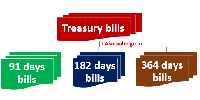
When the government is going to the financial market to raise money, it can do it by issuing two types of debt instruments – treasury bills and government bonds. Treasury bills are issued when the government need money for a shorter period while bonds are issued when it need debt for more than say five years.
Treasury bills; generally shortened as T-bills, have a maximum maturity of a 364 days. Hence, they are categorized as money market instruments (money market deals with funds with a maturity of less than one year).
Treasury bills are presently issued in three maturities, namely, 91 day, 182 day and 364 day. Treasury bills are zero coupon securities and pay no interest. Rather, they are issued at a discount (at a reduced amount) and redeemed (given back money) at the face value at maturity. For example, a 91 day Treasury bill of Rs.100/- (face value) may be issued at say Rs. 98.20, that is, at a discount of say, Rs.1.80 and would be redeemed at the face value of Rs.100/-. This means that you can get a hundred-rupee treasury bill at a lower price and can get Rupees hundred at maturity.
The return to the investors is the difference between the maturity value or the face value (that is Rs.100) and the issue price. The Reserve Bank of India conducts auctions usually every Wednesday to issue T-bills. The rational is that since their maturity is lower, it is more convenient to avoid intra period interest payments.
Treasury bills are usually held by financial institutions including banks. They have a very important role in the financial market beyond investment instruments. Banks give treasury bills to the RBI to get money under repo. Similarly, they can keep it as part of SLR.
*********









